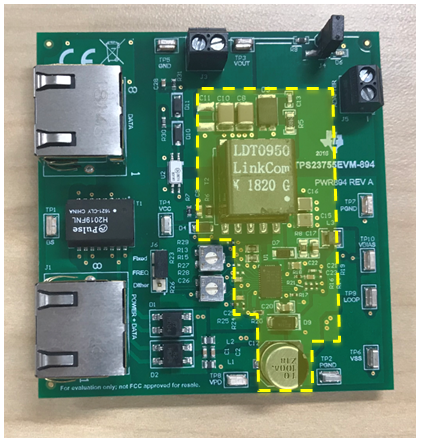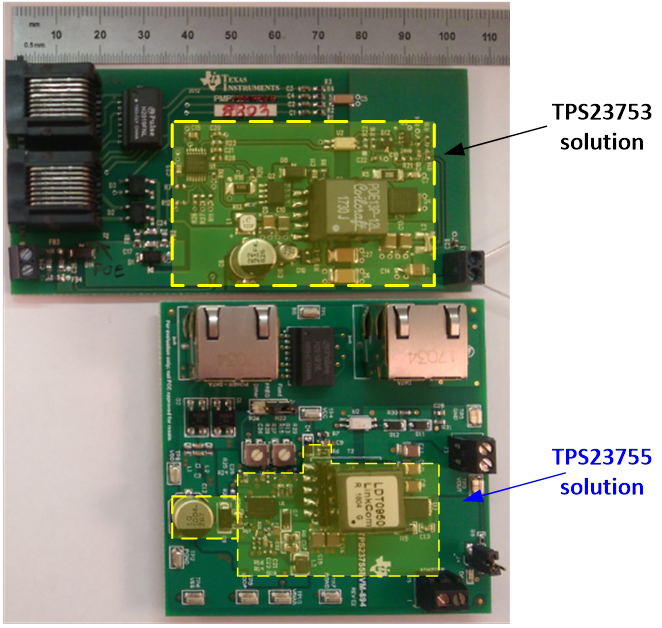SSZT458 june 2019 TPS23753 , TPS23753A , TPS23755 , TPS23758

You just got a big product out the door and are enjoying some well-deserved downtime when your product manager decides to swing by. Surprise, surprise: he wants the next-generation product to have more features and a smaller form factor. Luckily, you may be able to squeeze out some area from your Power over Ethernet (PoE) powered device (PD) solution.
If you’re after power density, consider the following when choosing a new PoE PD controller:
- Does it integrate a PoE PD front end and a DC/DC controller? Does it have an integrated PD field-effect transistor (FET) and an integrated switching FET? Higher integration will usually save board space and streamline the supply chain, since fewer components need to be purchased and planned for. For a robust solution consider a 100-V PD FET and a 150-V switching FET. This will provide margin against variation of the clamping voltage of the input TVS and the ringing of the switching node in the Flyback.
- Does the PoE PD controller offer primary side regulation (PSR)? PSR is a crucial feature that will enable you to remove the optocoupler and shunt reference, along with the diodes and resistor capacitors used for soft start.
- Does it offer spread-spectrum frequency dithering (SSFD)? This feature reduces electromagnetic interference (EMI) by spreading the noise in a broader frequency band. SSFD typically results in a reduction of 4-6 dB at the fundamental switching frequency and 10-20 dB for higher-frequency harmonics, enabling a ~2x reduction in the high-voltage common-mode capacitors, which are usually big and expensive.
- Does the PoE PD controller operate in continuous conduction mode (CCM) or discontinuous conduction mode? CCM has lower peak currents, which enables you to use lower input and output capacitors and injects less noise, thus requiring smaller filtering components.
- Does it feature advanced startup? This feature provides full current to the DC/DC controller during the soft-start phase before the auxiliary winding is fully up. Advanced startup allows you to reduce the VCC capacitor from ~22 µF to 1 µF, enabling the use of a ceramic capacitor, which is smaller and more reliable.
TI’s newly released TPS23755 is a Type 1 (limited to 13W of input power) PoE PD device that checks all of the above boxes.
Figure 1 shows a visual comparison between a 12-V, 1-A solution for the TPS23753A vs. the new TPS23755 solution. Note that the figure does not include the EMI filter. The TPS23753A operates in CCM mode and integrates the PoE PD (integrated FET) with a DC/DC controller. The TPS23755 adds the integrated switching FET, PSR, advanced startup and SSFD.
 Figure 1 Board Space Comparison for
TPS23755 vs. TPS23753
Figure 1 Board Space Comparison for
TPS23755 vs. TPS23753To appease your product manager and squeeze out some area from your PoE PD solution, consider evaluating TI’s TPS23755 evaluation module for IEEE 802.3at Type 1 PoE PD applications and “IEEE 802.3at Type-1 PoE and 12-V adapter input to point of load reference design for IP network camera” to get started with your Type 1 PoE design. For applications requiring 5V output consider evaluating TI’s TPS23758 evaluation module for IEEE 802.3at Type 1 PoE PD applications.
Additional Resources
- Watch these videos:
- Read the short article, “Would you like a logo to go with your PoE system?”
- Read the application note, “Practical Guidelines to Designing an EMI Compliant PoE Powered Device with Isolated Flyback.”